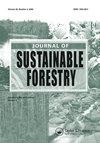哥斯达黎加16种热带森林产木炭的物理能量特性、抗压强度和化学改性
IF 1.8
4区 农林科学
Q3 FORESTRY
引用次数: 4
摘要
摘要:从快速生长的人工林中提取的木本植物生产木炭在各种用途中都具有重要意义。本工作的目的是测定哥斯达黎加16种快速生长的热带木材在450°C下热解产生的木炭的密度、抗压性、含水量(MC)、总热值(GCV)、灰分和挥发性含量、傅立叶变换红外光谱(FTIR)化学改性和热重降解。结果表明,MC值为2.65–7.72%,密度为0.15–0.39 g/cm3,抗压强度为19.07–82.92 kg/cm2,灰分为0.26–7.98%,GCV为32.10–24.29 MJ/kg,挥发性物质为22.45–33.34%,固定碳为60.36–68.91%,碳为78.51–69.43%,氢为4.15–3.55%,氧为17.25–26.56%,O/C比为0.17–0.29,H/C比为0.56–0.64。FTIR光谱证明了在热解生物质中常见的OH、CH2、C=O、C-O-C基团的存在。TGA分析显示了两种类型的行为,不同之处在于一组在200°C和800°C之间出现两个峰。应用主成分(PC)对16个物种的木炭特性进行多元分析,结果表明,这些特性的变化可以解释99%,并建立了四组。本文章由计算机程序翻译,如有差异,请以英文原文为准。
Physical and Energy Characteristics, Compression Strength and Chemical Modification of Charcoal Produced from Sixteen Tropical Woods in Costa Rica
ABSTRACT Charcoal production from woody species from fast-growth plantations has gained importance in a variety of uses. The objective of the present work is to determine the density, compression resistance, moisture content (MC), gross calorific value (GCV), ash and volatile content, chemical modification by Fourier-transform infrared spectroscopy (FTIR) spectrum and thermogravimetric degradation of charcoal produced by pyrolysis at 450°C from sixteen tropical woods from fast-growth plantations in Costa Rica. The results showed values of MC of 2.65–7.72%, density of 0.15–0.39 g/cm3, compression strength of 19.07–82.92 kg/cm2, ash content of 0.26–7.98%, GCV of 32.10–24.29 MJ/kg, volatile matter of 22.45–33.34%, fixed carbon of 60.36–68.91%, carbon of 78.51–69.43%, hydrogen of 4.15–3.55%, oxygen of 17.25–26.56%, O/C ratio of 0.17–0.29 and H/C ratio of 0.56–0.64. FTIR spectrum evidenced the presence of OH, CH2, C = O, C-O-C groups, common in pyrolyzed biomass. TGA analysis showed two types of behavior, which differ in that one group presents two peaks between 200°C and 800°C. The multivariate analysis by principal components (PC) applied to charcoal characteristics measured in sixteen species showed that the variations of these characteristics can be explained up to 99% and four groups were established.
求助全文
通过发布文献求助,成功后即可免费获取论文全文。
去求助
来源期刊

Journal of Sustainable Forestry
Social Sciences-Geography, Planning and Development
CiteScore
3.90
自引率
12.50%
发文量
42
期刊介绍:
Journal of Sustainable Forestry publishes peer-reviewed, original research on forest science. While the emphasis is on sustainable use of forest products and services, the journal covers a wide range of topics from the underlying biology and ecology of forests to the social, economic and policy aspects of forestry. Short communications and review papers that provide a clear theoretical, conceptual or methodological contribution to the existing literature are also included in the journal.
Common topics covered in the Journal of Sustainable Forestry include:
• Ecology, management, recreation, restoration and silvicultural systems of all forest types, including urban forests
• All aspects of forest biology, including ecophysiology, entomology, pathology, genetics, tree breeding, and biotechnology
• Wood properties, forest biomass, bioenergy, and carbon sequestration
• Simulation modeling, inventory, quantitative methods, and remote sensing
• Environmental pollution, fire and climate change impacts, and adaptation and mitigation in forests
• Forest engineering, economics, human dimensions, natural resource policy, and planning
Journal of Sustainable Forestry provides an international forum for dialogue between research scientists, forest managers, economists and policy and decision makers who share the common vision of the sustainable use of natural resources.
 求助内容:
求助内容: 应助结果提醒方式:
应助结果提醒方式:


